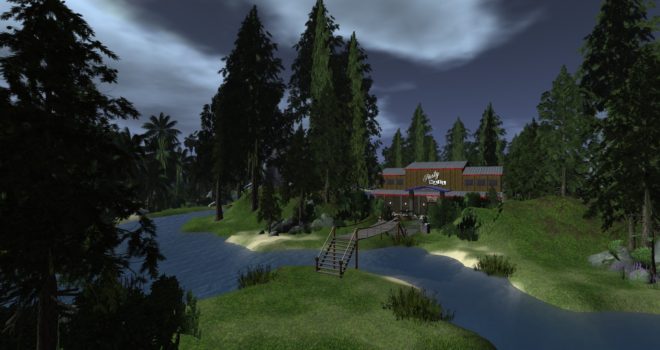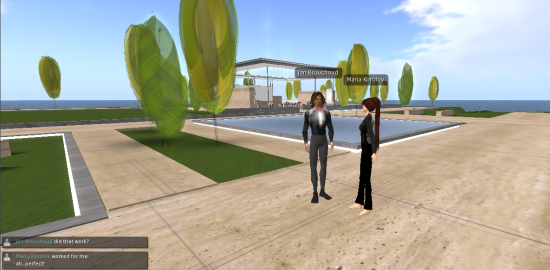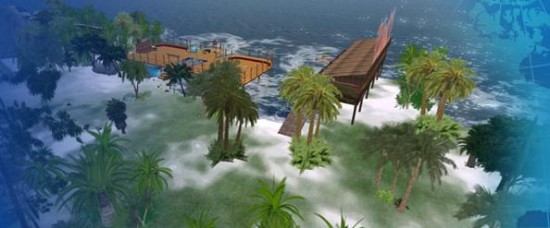Latest update: April 8, 2013
This is a primer for folks considering moving into OpenSim who have never used OpenSim before and who don’t have much of a technical background.

First look at OpenSim
If you want to get into OpenSim in the quickest, easiest way possible, just follow this link:Â http://www.kitely.com/virtual-world/Maria-Korolov/Linda-Kellie-Freebie-Mall
You will need a Facebook or Twitter account to sign up — or just an email address — and if you’ve never used Kitely before, it will install a small configuration tool on your desktop. Then it will log you in and take you right into my region, which is a shopping mall filled with content licensed to use in any way you want, including commercial.
Kitely runs the latest stable version of OpenSim, so you’ll have sculpties, media-on-a-prim, and mesh. Wander around and see how it works.
Like it? Go back to your Kitely screen and click on your name at the top right of the screen. Now hit the “Create world” button. Choose from an empty region, an OpenVCE conference center, or upload your own OAR file. (Where do you get OAR files? Here.)
Now choose who can access your world — just you, everyone, or only members of a particular Facebook group.
And you’ve got your own OpenSim region up and running. Click on the region name to enter it.

The region is completely free. You can have up to 100 simultaneous avatars on it. And up to 100,000 prims. The catch? You can only access it for six hours the first month, and two hours a month each month after that.
If that’s not enough time for you, you can upgrade to one of Kitely’s paid options. For $40 a month, for example, you and anyone you allow access to can spend as much time on the region as you want. Kitely can afford to do this because when the region is empty, it automatically goes to sleep, and wakes up again whenever anyone teleports or logs in.
And if you want to save some money, you can switch to one of the time-based billing plans. For example, if you spend less than 30 hours a month on your land and expect no visitors — or are willing to have your visitors pay their own way — you can sign up for the $5 plan, which comes with two regions at no additional cost. If you spend up to 120 hours a month on your land — that’s an average of four hours a day — $20 per month will also get you 10 regions. And for $35 a month, you get unlimited use of 20 regions. That’s 20 regions, each holding up to 100,000 prims.
If you need to add more time, or more regions, to any plan, Kitely also has a-la-carte options. Each additional region is around $1 month. Each additional hour of usage is around 20 cents.
By comparison, Second Life will charge you around $300 a month with a $1,000 setup fee for a single region that can hold up to 15,000 prims.
The downside is that Kitely doesn’t have the community that Second Life does. But its low land costs and high prim allowances makes it perfect for builders looking for a place to have a warehouse of objects that they upload to Second Life for sale, for educators and businesses looking for private space for meetings, training, and simulations, and for roleplaying groups looking to create their own kingdoms at low prices, and without needing any technical skills.
Kitely is currently building a marketplace, and is expected to have hypergrid teleport connectivity to other OpenSim grids later on this year. In addition, Kitely also offers megaregions of up to 16 regions in size, and on-demand region backups that include everything on a region that you’re allowed to copy and download. These backups are standard OpenSim OAR files and can be moved to any other hosting provider and most other grids, shared with friends or colleagues, or just used as permanent personal backups.
Home, home on the grid
Your little Kitely island — or dozen Kitely islands — might be enough for you and your Facebook friends, colleagues, or students. But if you want to be part of a larger world, you’ll want a region on a big social grid.
The largest public grid is OSgrid.
Many people connect regions that they run on their own servers or home computers, but if you’re not technically inclined, you can also rent land from any of several different hosting companies.
The most reputable of these is Dreamland Metaverse, which is one of the oldest hosting providers out there, and also the one with the best reputation for customer service. A Second Life-style region capable of holding 15,000 prims will run you $30 a month with no setup fee.
The lowest-cost provider is Oliveira Virtual Lands, where 15,000-prim regions go for $12 a month with one week free trial.
The newest provider in this space is Zetamex, where a 15,000-prim region goes for $20 a month with an option to turn it into a nine-region megaregion at no extra charge.
To compare hosting providers, visit our OpenSim Hosting Providers page. Most of those in the left-hand column, under “Multi Grid,” will be able to provide a region on OSGrid or any other public, open grid.
Other popular open grids include FrancoGrid, Metropolis, and Craft.
But while OSgrid is the largest grid running OpenSim, and the most popular open grid, it is not the most popular grid overall — that honor goes to InWorldz. In addition, because OSgrid and other open grids allow anyone to connect regions or hypergrid teleport to other grids, it’s easy for content to leave these grids.
If you need a grid where content is more secure, or one with strong, professionally-managed communities, you might consider renting land from a commercial grid instead.

In addition to InWorldz, other popular closed, commercial grids Avination, Island Oasis, 3rd Rock Grid, and AviWorlds. Each commercial grid sells its own regions and sets its own prices. The prices for the commercial grids are listed on the right-hand column of the OpenSim Hosting Providers page, under “Single grid.” Closed commercial grids focus on providing a high-quality experience for their merchants and residents, and restrict content from moving off-grid, but can also be more expensive than open grids, with typical region prices around $60 a month.
In addition, because of content protection measures, users have limited options for making backups of their regions and inventories, and are typically prohibited from teleporting out to other grids.
For more information about public grids, check out the OpenSim Grid List, which lists all the public grids, their maturity levels, voice options, hypergrid, currency, and other info. For more information about grid types, read:Â An OpenSim grid primer.
There’s no grid like your own grid
Ready to move up to your own grid? It’s as easy to have a whole grid as it is to have a single region, at little or no additional cost. You get to decide who gets an account on your grid and control all access. You decide what content goes where, and you can turn hypergrid on or off.
If you’re only going to need a few regions, go for a mini-grid. Since the whole grid can fit on one server, no additional grid infrastructure is needed to manage it, so there’s usually no additional cost. In fact, you might get a discount for ordering several regions at once. Plus, you can have the whole grid be one mega-region — no border crossings! Ask your hosting provider for a Diva Distro-style minigrid. Dreamland Metaverse, SimHost, and Zetamex are our recommended providers for mini-grids, but you may want to pick another provider because of geographic proximity or support for your language. Talent Raspel, for example, is in Germany. SecondPlaces is based in the U.K.
A mini-grid is a good option for a school or small company. And if you ever need it, your hosting provider can upgrade you to a full grid. Moving regions is as simple as downloading the OAR file from the old grid, and uploading it to the new one. And to move an avatar, download the IAR file — inventory archive — and upload it to new grid. Today, this process is typically done manually, so if you expect to be getting a lot of users, you might want to start right out with a full grid.
A full grid differs from a mini-grid is that it can spread across multiple machines. As a result, it requires a centralized grid management server to keep track of where all the regions are, and to store the user accounts and their inventories. The price for this, including a grid management panel, is $45 a month from Dreamland Metaverse.
By using one of these services, you can run anything from a medium-sized school or company grid, to a social grid with hundreds of regions and thousands of users.
The hosting provider handles all the technical issues — setting up and maintaining the servers, keeping the software current, continually adding new features, even providing tech support.
All you have to do is take care of the people and the content.
Where to get content for your region
If you have content that you have created elsewhere, such as in Second Life, you can use Imprudence to export individual objects and upload them again to your destination grid. You can only export objects that you yourself have created, and where you are the creator of all constituent parts, as well, including all textures. To export scripts, you will have to save each script individually to your hard drive or cut-and-paste them. More information on using Imprudence to move content between grids is here.
If you are renting your region from a commercial grid like InWorldz or Avination, you will have a variety of in-world shopping destinations to choose from.
If you have a region on a hypergrid-enabled grid like OSgrid or FrancoGrid then, in addition to the in-world markets and freebie stores, you can also teleport to those on other grids. Samsara, Snoopies, and Wright Plaza have large collections of freebies on OSgrid. Get to know the shop keeper, and be ready to ask for a refund — or an alternate delivery mechanism — if you’re not able to take your purchase home with you.
If you are renting land from Kitely, Dreamland Metaverse, Zetamex, Oliveira or another hosting provider who allows you to upload OAR and IAR files, your options are even bigger — and growing quickly.
An OAR is a complete region archive, a backup file which includes the region terrain and all the objects, textures and scripts that are located on that region. An IAR is a complete inventory archive, a backup which includes all the objects, shapes, textures, scripts and other content in an avatar inventory.
Most commercial grids will not allow you to export an OAR or an IAR file from their grid, to keep content from leaving their world. But they might be more amenable to allowing you to import an OAR or IAR file, especially if it’s from a reputable source like Linda Kellie.
OpenSim Creations also has a nice selection of free OAR files, as well as other types of free, Creative Commons-licensed content. Read more about finding content here:  Where to get content for OpenSim.
- Kitely Mega Worlds on sale for $90 per month - July 19, 2024
- OpenSim regions up, actives down with summer heat - July 15, 2024
- People think AIs are conscious. What could this mean for bots in OpenSim? - July 12, 2024
